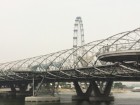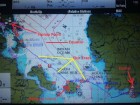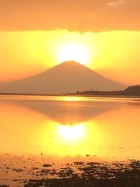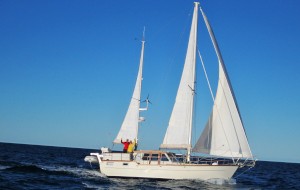Kailana
| Vessel Name: | Kailana |
| Vessel Make/Model: | Nauticat 38 |
| Hailing Port: | Fremantle |
06 November 2014
15. Singapore
Singapore is an amazing city. It is the city that never sleeps, always something going on with a plethora of places to eat, shop and drink. You can buy a cheap meal in a hawkers food stall for $3-5 (Beef Hor Fun quite a good choice) or you can go to a fine dining establishment and feel the need to either [...]
06 November 2014
14. Kumai to Singapore
From leaving Kumai (Borneo) we headed to Pulau Belitung. A distance of 330Nm, which we completed in 51 hours, hence 2x overnighters in a trot - not really our favourite. There was quite a bit of traffic to avoid at night, with both tankers and fishermen dotting our path north and not always on AIS, so [...]
26 October 2014
13. Kumai (Borneo)
We were quite surprised to hear that Sam, our Sail Indonesia agent, had made his way to Kumai. After going AWOL in Bali we basically wrote him off as being of any assistance with our visas, leaving it to a 'proxy' Agent named Ruth to organise the passports to be sent to Nongsa Point, our designated check-out [...]
22 October 2014
12. Java Sea Crossing
In the last blog we were happily sailing away from Bali, safe in the knowledge that our passports and visa extensions were speedily and professionally being processed before being sent ahead of us. Or were they? We had now dropped behind all the rally boats due to the immigration administration slow-boat [...]
07 October 2014
11. Gilli Air & Bali
The last you heard from us we were on our way to Lombok from Sumbawa. We are now back in the company of our other yachties. The crossing to Lombok was easy enough, only being able to sail about half the way. We stayed in a decent enough anchorage on the North East of Lombok, which proved to be a bit [...]
17 September 2014
10. Labuan Bajo to Sumbawa (via Komodo & Rinca Islands)
Indonesia really is a unique place. With a population of about 190 million, it has 300 different ethnic groups living within it, over 13,000 islands, with 580 languages and dialects spoken. That is diversity at its best. Not only does it have the largest population of Muslims, but it also has the [...]
2. Darwin to Kupang

We rested the best we could on the Friday night and at 6:30 we were up and ready to go, just as the sun was coming up. It's not the sort of thing you forget to do, a 500 miles yacht rally. "I'm sure I was meant to do something today", doesn't really feature in your vocabulary. Missing the offical start meant missing all the boats all leaving together, all coloured flags and all the other yachtie paraphenelia, but being within the pelaton also has its dangers. Being out in front meant that the time that any boats would catch us up we would be well spread out. Also, with the additional springboard of the tide we would have quite a head start.
Fannie Bay anchorage was flat as a pancake, not a breath of wind to be had. We very slowly motored out of the anchorage, almost like we were sneaking away, like a 'one night stand' kind of thing, leaving all the sleeping rally boats behind. Our buddies Esoterica, Apa Lagi and Sagata were at the rendeviour point bang on time. It was really nice to be back on water, cruising in company, banter on the VHF radio, etc. Months of preperation all for this, the start of another Heist adventure! We quickly cleared the harbour, turned left and set ourselves on a heading of 290-degrees for Kupang, directly across the Timor Sea.
We had a little bit of wind behind us, but only enough to keep the head sail open, not really adding anything to our progress. The wind for almost the entire journey did not change from pretty much directly behind us. Sailboats don't really like to be sailing directly downwind. We also had swell come at us from the stern of our starboard side, this tending to make the boat roll side to side. With only light breezes, the swaying back and forth is more that the wind can keep the sail full, so the sail fills, collapses, then fills again with a bang, then collapses, on an on it goes. Some may ask why we didn't hoist our spinaker sail. Well, we're scared of it, simple as that! We might get our nerve up to hoist it in Asia as winds tend to be kinder here compared to the westcoast of Australia.
So, it wasn't long before the sail was brought down and all we were doing was releasing carbon into the environment and keeping our Oil & Gas pals in employment. We tried over a number of times to hoist the head sail, changing headings, etc to keep the head sail filled, but changing heading meant the boat rolled more and made the situation worse. Changing heading also increased distance to cover, rendering the assisted speed from the sails of no use at all. We weren't along with this problem, pretty much all the yachts did the same thing.
The first day turned into night, then turned into day again. We sort of got into routines of watch, but it is difficult, we were both still on adrenalin. But there was no other traffic out there. We were clearly ahead of the pelaton, which means hours and hours of nothing but horizon and one other sailboat - Sagata. Being so far away from land and any city lights, the sky was packed full of stars and shooting stars everywhere. We have a number of systems that are our eyes in the dark. Our primary means of seeing other vessels is AIS. This is a wonderful system where a vessel will transmit a little package of information over VHF telling other vessels their position, heading, speed, vessel name & particulars. Kailana also transmits our data to all receiving vessels. If there is a chance of a collision an alarm will sound. Other than Sagata there were no other vessels, no lights, nothing. At nights we also used our radar. We can set up a sector watch where an area in front of us is closely monitiored. If anything is to pass into this area an alarm is sounded. Again, nothing. So, staying awake becomes an issue. Nothing on AIS, no lights, nothing on radar, pitch dark all around. You may think boring, but time passes at lightening speed. There is always something to preoccupy yourself with.
The first day we covered 190 nautical miles for 24 hours, averaging just under 8 knots. This is fairly quick for us. The wind did not change, same, same but no different. There was a couple of 'daily calls', to catch up with all the other boats. This is a loose agreement that at predefined intervals during the day all vessels will call in on the HF radio to tell there position and conditions onboard. Our HF is now working! It packed in sometime last year and was put into the 'too hard basket'. In Darwin Kev managed to coherse an HF engineer aboard for a quick look and he identified the problem as some dodgy wiring and a blown internal fuse within the unit.
Sometime in the second day an AIS vessel popped up on the GPS. Not long after a large mast and full sails appeared on the horizon and within a couple of hours this flying machine was gone over the blue yonder. It was Equinox, a stripped out thoroughbred racing machine. On the evening of the second night we passed very close to Bayu Undan, Conoco's gas development right in the middle of the Timor Sea. Prior to getting to the platform we came across our first Indonesian fishing boat, seemingly skirting along the border line between Australia and Indonesia. It is a strange sight when you are used to seeing typical western vessels, to then see a brightly painted wooden craft clearly of a different world, typical of what you see on TV as an asylum seeker boat. They obviously knew where they were and where they were going so we chose not to call it in as a potential threat to the Australian continent! We were also buzzed by an Australian customs plane, asking the vessel at the approximate postion who we were and where we were going.
Throughout the trip so far we had several pods of dolphins racing along in our bow. They can be there for several minutes, seemingly having a blast playing below the bow sprit.
Bay Undan quckly dropped behind us and we were alone again for another evening of nothing. The second day for the 24 hours saw us cover 191 nautical miles, almost exactly the same as the first day, again averaging just under 8 knots.
On the third day we are in Indonesian waters. With being in Indonesian waters there is more emphasis on ensuring watches are carried out. Many of the vessels may not be lit and difficult to pick up on radar. The third day saw the wind change slightly to our beam so we bid farewell for now to Sagata, hoisted the head & mizzen sails and turned the engine off. After 51 hours of rumbling diesel it is such a pleasure to then have silence with nothing but the slosh of the water passing over our hull. Sagata continued to motor, but our intention was to slow down. We had covered a lot of distance and continuing at this speed saw us making land in the dark. The pelaton was lumbering on behind us some 100-150 miles back. We managed to cover 50 miles with the motor off before the wind was again behind us, the seas rolly and upsetting our progress with slappy sails, etc. The iron main was hoisted (yachtie talk for starting the engine) and we were off again.
To get to Kupang you have to pass through a narrowish passage, but it is known to be full of unlit stuff. At about midnight we were closing in on this passage with the wind about 20 knots on our bum and pushing against 1 knot of tide. When you have the wind blowing in one direction against an opposing tidal flow, you tend to get horrible short, deep waves. The sea can become 'confused', with sloppiness passing this way and that. To add to this we were getting in amongst fishing vessels, presumably pulling nets behind. The closer to land we got to waves became deeper and breaking all around. All boats will tend to surf down the fronts of these waves, then almost come to a stop at the trough of the wave, before being picked up on the next for an exciting surf. This is all a bit of fun on a sunny day, in familiar waters, with a bunch of mates. After 3 days with vitually no sleep, in a foreign country, with badly lit fishing boats, possibly pulling nets, in the dark, it all starts to get a bit, well, scarey!
Passing into the final passage to Kupang wasn't an option until it was light, so we ducked around behind Roti (Bread) Island to get shelter from the wind and waves. Both Sagata and ourselves set our boats up in a 'hove to' arrangement, where the vessel will just drift beam onto the wind, but stable and happy. We were drifting at about 0.5 knot away from the island, with flat seas for the first time since Darwin. Setting up drift alarms, radar watch, etc, we both managed to get a couple of hours of very, very deep sleep.
Just before first light we were up and away again under full sail towards the Kupang channel. We took down out Australian, Scottish & Canadian flags and replaced them with our Indonesia and 'Q' flag, an all yellow flag donating that we were free of contamination and ready to be boarded by immigation and customs officials. This is standard practice for all vessels entering a foreign country. As it got lighter we could see where we were and the Indonesian coastline for the first time. We had almost made it and were quite chuffed with ourselves, only the 25 miles to Kupang remained. The channel proved to be easy in the daytime, only a number of floaty fish trap things to avoid, almost certainly something to tangle with in the dark. Now we could see many other Indonesian boats, houses and then people. It is a strange experience coming from the comforts of Australia to this alien kingdom, a bit like staring out of the window when coming into land on an airplane to a new country. Several hours later we came into sight of Kupang and some of the other yachts that were ahead of us at anchor. These boats now looked out of place.
We dropped anchor at about 10am local time, about 75 hours after lifting the anchor, covering a total distance of 542 nautical miles, but running the engine for 64 hours (we know, shameful for a sail boat!). Apart from a leaking diesel filter and a protruding anchor light wire from the mast (our fault with the incorrect wire choice), Kailana was as good as gold!






